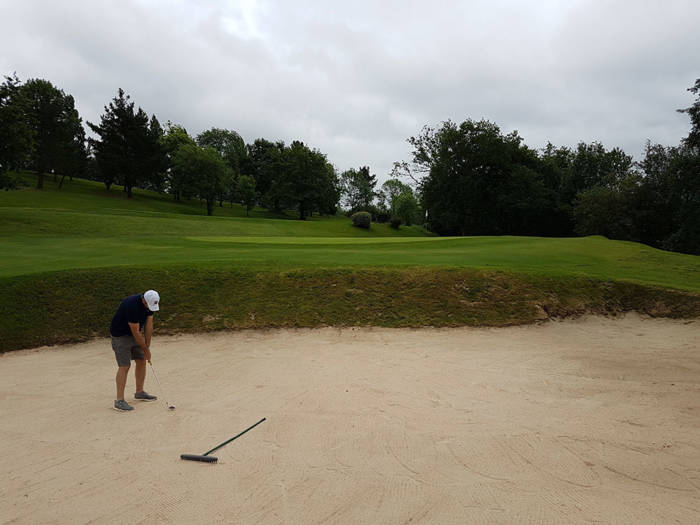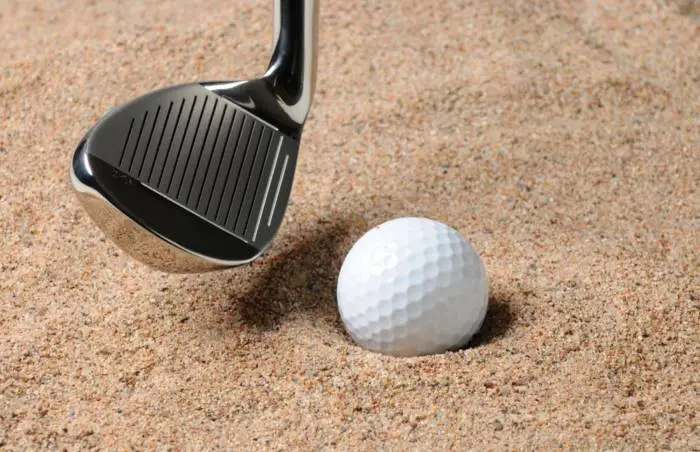What Degree is a Sand Wedge?
Your wedges are some of the most important of all your golf clubs. On average 60%-70% of your shots will be played from 100 yards and in, which is where your wedge game is focussed.
Wedges are also incredibly versatile and can be your saviours to get out of some of the most difficult of situations on the course..
In this guide, we’re going to look at what degree of loft a sand wedge and other types of wedges have. From this, you should have a better idea of how each club works and how to use them properly.

How many degrees is a sand wedge?
A sand wedge will typically have 56 degrees of loft.
However, depending on the manufacturer this could be a loft between 54 and 58 degrees. In most sets, the sand wedge will be the club with the highest loft, which makes it one of the most important clubs in the bag.
The higher the loft on the golf club, the higher the shots that can be hit. And although the sand wedge is used for full shots within a certain range, they are also your go to tool to escape out of a tricky spot, which is what it excels at. And as the name suggests, it’s primarily designed to help you in the sand!
One of the most important aspects of the sand wedge is not just the loft angle, but also the bounce on the club.
The sand wedge has a more rounded sole of the club (with 10-14 degrees of bounce). The bounce is designed to bounce back off the playing surface. This avoids the club digging into the sand and slowing the swing down.
The combination of higher loft and higher bounce is key for playing a sand wedge out of a bunker. Together they help get the ball out of the sand, putting a bit of spin and control on the ball to help you leave it closer to the pin.
What is loft?

Quite simply, the loft is the angle between the ground and the club face. The loft of the club controls how much height you are able to generate on your shot, alongside the distance that the ball will travel.
You can find the standard loft for each golf club in our guide here.
Distance clubs focussed golf clubs, such as drivers and woods, have a much flatter loft angle which gets close to perpendicular with the ground, as this generates much more distance and power which is required of these types of clubs.
For approach play and the short game, control and height are often much more important than power, which is why wedges have a much more drastic loft angle that provides this control and height, while relinquishing distance and power.
Different types of wedges explained
There are several other clubs that offer higher lofts. Amongst your irons the higher the number, the higher the loft. Generally, your 9 iron will be the iron with the highest loft in the bag, and irons below this will start to offer much less loft.
Some other options are the specialist wedges, such as the gap wedge, lob wedge and even the pitching wedge.
It’s important to note that the loft angle of clubs isn’t always exactly the same or totally standardised, and custom-fitted clubs and different brands can offer different loft angles for the same club depending on the various specifications of that club and what the golfer has requested.
It’s also possible to slightly alter the loft angle of existing clubs by getting them adjusted, allowing you to make your clubs suit your needs perfectly.
What degree is a pitching wedge?
The pitching wedge typically has a loft angle of 44 to 48 degrees depending on the brand and style of the club.
As the pitching wedge has less loft than a sand wedge, the ball will come out slightly lower, promoting more distance and roll on the green. This makes the pitching wedge the perfect choice for a lot of approach shots making it an essential club that is carried by most golfers.
What degree is a gap wedge?
The gap wedge is a lesser-used club among average players but is very useful as it fills a gap between the sand wedge and pitching wedge.
Typically a gap wedge gap wedge has a loft between 50 and 54 degrees.
Golfers usually have around a 30-yard distance gap between a sand wedge and a pitching wedge, and the gap wedge is there to fill that distance gap.
A gap wedge is a great option for golfers that prefer to hit full shots from the fairway, as you don’t have to rely on hitting three quarter or half pitching wedge shots when you find yourself at a distance between the sand and pitching wedge.
It also offers an extra dimension close to the greens, offering a slightly stronger flight to the sand wedge with a little more spin control than a pitching wedge. They work wonders from 40-60 yards.
What degree is a lob wedge?
The lob wedge is the most-lofted club available in golf. It has a degree angle of 58 to 64 (with 60 degrees being the most common).
Lob wedges are designed specifically for very short approach shots where excellent elevation and good control is needed.
They are also great for getting out of bunkers. Particularly on links courses where the bunkers have very steep faces and require instant loft on the shots.
What degree is a 9-iron?
The 9 iron is the most lofted of all the irons, with a loft of 41 to 43 degrees depending on the brand of club.
It’s designed for range of approach shots or escaping the rough near the fairway, giving it a considerable distance boost over a pitching wedge.
FAQs about golf wedges
Below we’ve answered some of the most common questions we face on the different types of wedges.
No, a 60-degree wedge would be classed as a lob wedge
Yes, a 56 degree wedge and sand wedge are the same thing. If you buy a full set of irons, it will usually be marked with “SW” on the bottom of the sole. However, if you buy your wedges separately, they will usually have the degree (56) stamped on the soles instead.
A 52 degree wedge is also known as a gap wedge. Gap wedges are less common golf clubs and are meant to fill in the distance gap between a sand wedge and pitching wedge.
A 52 degree wedge would be considered a gap wedge, not a sand wedge. You could open the face of the 52 gap wedge to play it like a sand wedge, but it will not have the same performance as a sand wedge.